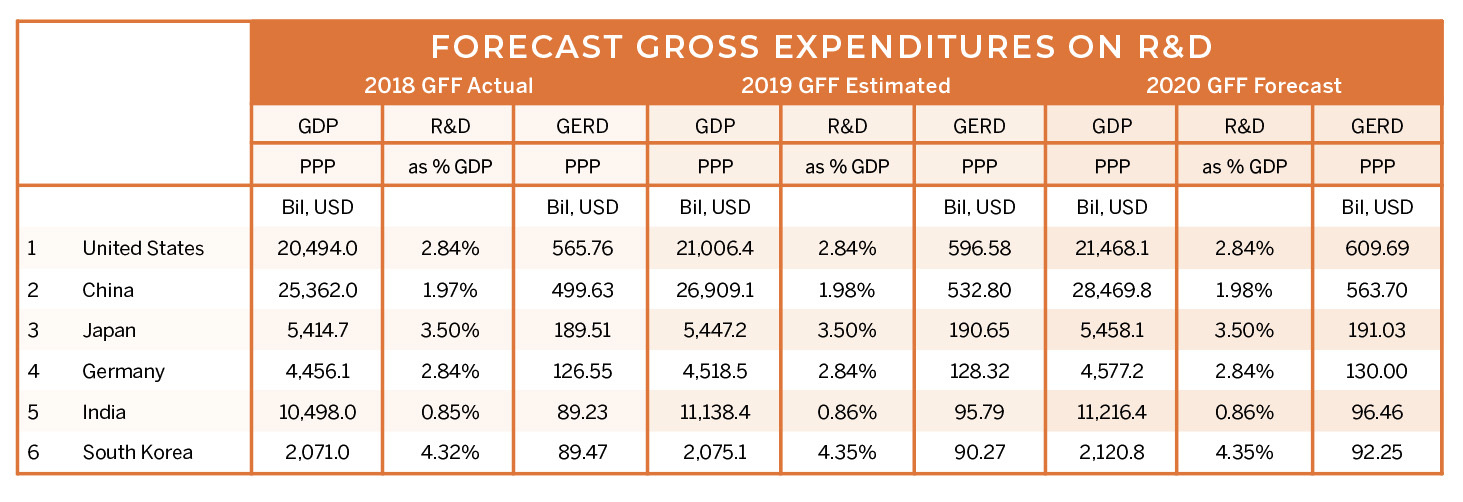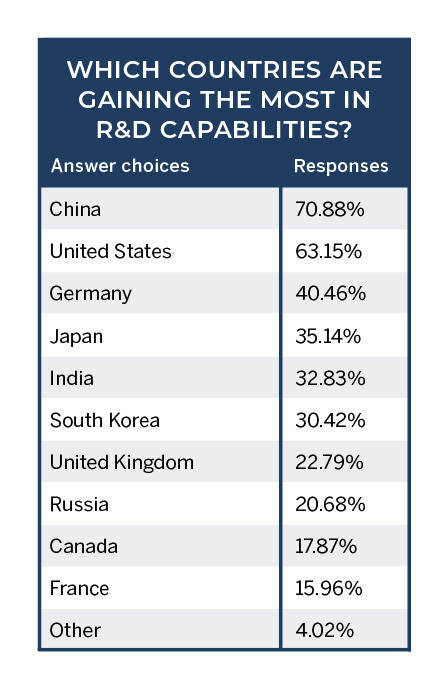A look at whether “to innovate, collaborate” is always the best strategy when it comes to global R&D
By Becky Chambers Hennessy
 If ever there were a need for innovation through intellectual exchange and collaboration it is this: the novel Coronavirus (COVID-19), reportedly first identified in China. R&D experts worldwide know this, and the U.S. Federal Drug Administration has joined with domestic and global partners in the R&D of medical countermeasures. The World Health Organization (WHO) and China are sharing expertise to help guide response efforts.
If ever there were a need for innovation through intellectual exchange and collaboration it is this: the novel Coronavirus (COVID-19), reportedly first identified in China. R&D experts worldwide know this, and the U.S. Federal Drug Administration has joined with domestic and global partners in the R&D of medical countermeasures. The World Health Organization (WHO) and China are sharing expertise to help guide response efforts.
“WHO is working closely with the government on measures to understand the virus,” said Director-General Tedros Adhanom Ghebreyesu. “WHO will keep working side-by-side with China and all other countries.”
This likely signals to the public that general global R&D collaboration is smooth-running, right? But research scientists, engineers and technical professionals are saying: not so fast. While it is true that R&D innovators worldwide increasingly are working side-by-side, growing concern over cooperative work with foreign entities such as China have created speed bumps. U.S. claims of China’s theft of intellectual property and its threat to national security has federal agencies such as the National Science Foundation (NSF) facing increasing pressure to monitor foreign engagement fostered by U.S. government funding.
This is happening as China emerges as an innovator both domestically and globally. R&D World magazine’s 2020 Global R&D Funding Forecast (GFF) and the publication’s 2019 Reader Surveys show China is close to becoming the top global R&D investor — and forecast to surpass total U.S. spending by no later than 2025 if current spending trends continue. Last year, the U.S. and China invested nearly half of all global R&D monies.
Addressing tensions
A recent report titled “Threats to the U.S. Research Enterprise: China’s Talent Recruitment Plans” by U.S. Senators Rob Portman (R-Ohio) and Tom Carper (D-Del.) recognizes America’s top standing in science and technology, much of it due to collaboration. “The collaborative openness of the U.S. research enterprise attracts investment, researchers and students, promotes a free exchange of ideas, and ensures the distribution of timely and relevant research. International collaboration also is a hallmark of the U.S. research enterprise.”

Figure 1.
Six R&D-spending countries are responsible for some 70% of all global R&D investments. In 2019, the U.S. and China invested about half of all global R&D monies. And the U.S. government, with $163 billion in R&D funding, invests more R&D monies alone than all other countries except for China and Japan, the 2020 GFF shows, Figure 1. The U.S. is the significant leader in the following technology market sectors: Advanced materials; agriculture/food, commercial aerospace, computing/IT, energy, information/communication technologies, instrumentation/electronics, life science/healthcare, and military/space/defense, Figure 2.

Figure 2.
But when asked which countries are gaining the most in R&D capabilities, those surveyed for the 2020 GFF ranked China as first among 10 countries at 71%, followed by the U.S. at 63%. (See sidebar for related Q&A commentary.) Together, China and the U.S. rank significantly higher than the third-listed country, Germany, at 40%, Figure 3.

Figure 3.
For years, federal agencies and others have made claims about foreign threats to U.S. research, from theft of government secrets to enticements of high-level researchers, and plagiarism of product designs and concepts, according to the 2020 GFF. Senator Carper echoes these claims, pointing to China.
“The Chinese government continues to exploit our federal grant programs to recruit U.S. researchers and scientists and, ultimately, transfer research that is funded by American taxpayers back to China,” said Carper. He added that “there are serious consequences that come from giving a foreign government so much control over the vital research we rely on to drive our country’s economic competitiveness.”
The 2020 GFF addresses ways in which Congress is addressing these concerns, including through the creation of two panels focused on foreign researchers working or studying in the U.S. One is charged with collecting actions from multiple government agencies to protect federally funded research from theft, cyber-attacks and other threats. The other, a roundtable by the National Academy of Sciences, is responsible for addressing politically sensitive threats from collaborations between foreign and U.S. researchers.
Striking a balance
In December 2019, NSF released a report by the independent science advisory group JASON titled “Fundamental Research Security” in response to growing concerns by lawmakers and security officials over the threat of foreign influences on the U.S. research enterprise. The report, which engaged academia, intelligence and other agencies, concluded that the threat is real — but should be addressed in ways that preserve the ability of the U.S. to attract international talent.
JASON reviewed evidence of problems with research transparency, reciprocity in collaborations and consortia, and reporting of commitments and potential conflicts of interest. But, the findings state, “the scale and scope of the problem remain poorly defined.” JASON concluded that problems involving foreign influence can be addressed within a framework of research integrity. “The benefits of openness in research and of the inclusion of talented foreign researchers dictate against measures that would wall off particular areas of fundamental research.”
In a March 2020 NSF Response to the JASON Report, NSF Director France A. Córdova wrote that NSF agrees with JASON’s finding that “the U.S. needs to continue to attract and retain the best science talent from across the globe.” NSF also “strongly agrees” with JASON’s views on the importance of foreign-born scientists training and working in the U.S. Córdova stated she “appreciates JASON’s affirmation that the actions of some foreign governments pose a significant threat to the U.S. research ecosystem,” adding that NSF has created a new position, chief of research security strategy and policy, to maintain scientific openness and collaboration while developing practices to assess risk and take action.
Among action taken to date by NSF, through its Office of Inspector General, is the termination of grant awards to those who failed to disclose foreign affiliations. This is in keeping with JASON’s call for research integrity to encompass disclosure of conflicts of interest and time commitment, with violations adjudicated much like that of falsification of data and other research misconduct. NSF recently announced additional actions to protect U.S. research while facilitating collaboration.
Continuing collaboration
 Regardless of China’s rise as a top innovator and concerns about foreign threats to U.S. research, global R&D remains strong and the trend toward large-scale collaborations continues. Examples abound, according to the 2020 Global R&D Funding Forecast:
Regardless of China’s rise as a top innovator and concerns about foreign threats to U.S. research, global R&D remains strong and the trend toward large-scale collaborations continues. Examples abound, according to the 2020 Global R&D Funding Forecast:
- The Israeli government’s Innovation Authority is financing a medical cannabis incubator, CanNegev, comprised of six start-ups that each have received a non-diluted loan, coupled with contributions from investment groups and others. More startups are planned in Northern Ireland and New Zealand.
- Microsoft announced plans to open a cloud computing region in Qatar where Azure is slated to come online in 2021, followed by Office 365 and Dynamics 365. Microsoft’s cloud competitor, Amazon Web Services, already has a cloud “outpost” in Bahrain.
- In 2019, Nestlé launched an R&D innovation challenge in South Africa to contribute to the local innovation ecosystem. Nestlé’s goal is to work collaboratively with startups and universities to identify sustainable and scalable solutions to accelerating the development of products that meet local consumer needs.
- General Motors (GM) won a 2019 R&D 100 Award for capacitor-assisted battery technology planned for use on future GM vehicles. It was developed at GM’s China Battery Lab, and researchers there will continue to explore novel energy solutions for future GM electric vehicles and hybrids.
While 44% of 2020 GFF survey respondents pointed to China as the largest foreign threat to future R&D efforts, fully half identified domestic competitors as the larger threat. Other parts of the world were not currently viewed as R&D frontrunners. Moving forward, it appears that collaboration opportunities among sectors and industries worldwide will depend on a willingness to innovate, share new products and services, and effectively address research integrity and security concerns.
RELATED: Three R&D experts weigh in on China as it rises to become the world’s top R&D investor.





Tell Us What You Think!